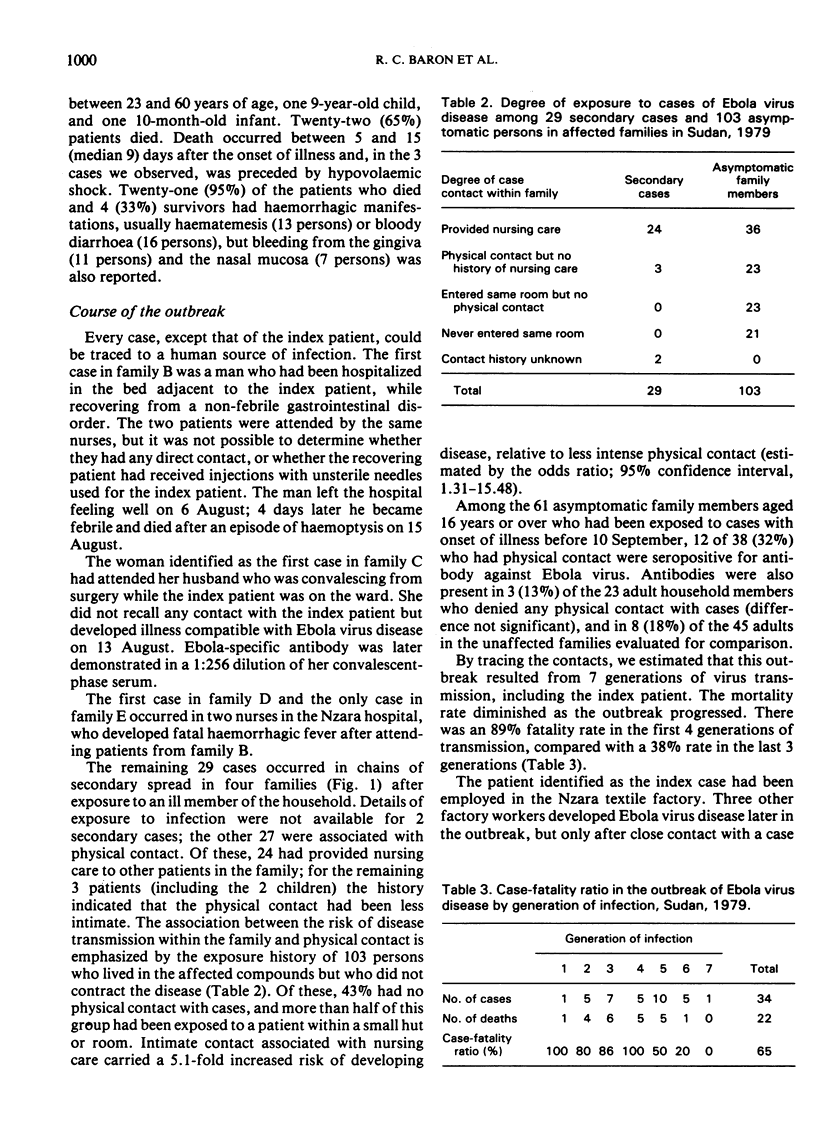Abstract
Between 31 July and 6 October 1979, 34 cases of Ebola virus disease (22 of which were fatal) occurred among five families in a rural district of southern Sudan; the disease was introduced into four of the families from a local hospital. Chains of secondary spread within the family units, accounting for 29 cases resulted from direct physical contact with an infected person. Among all persons with such contact in the family setting, those who provided nursing care had a 5.1-fold increased risk of infection, emphasizing the importance of intimate contact in the spread of this disease. The absence of illness among persons who were exposed to cases in confined spaces, but without physical contact, confirmed previous impressions that there is no risk of airborne transmission. While the ecology of Ebola virus is unknown, the presence of anti-Ebola antibodies in the sera of 18% of persons who were unassociated with the outbreak suggests that the region is an endemic focus of Ebola virus activity.
Full text
PDF






Selected References
These references are in PubMed. This may not be the complete list of references from this article.
- Bowen E. T., Lloyd G., Harris W. J., Platt G. S., Baskerville A., Vella E. E. Viral haemorrhagic fever in southern Sudan and northern Zaire. Preliminary studies on the aetiological agent. Lancet. 1977 Mar 12;1(8011):571–573. doi: 10.1016/s0140-6736(77)92001-3. [DOI] [PubMed] [Google Scholar]
- Burney M. I., Ghafoor A., Saleen M., Webb P. A., Casals J. Nosocomial outbreak of viral hemorrhagic fever caused by Crimean Hemorrhagic fever-Congo virus in Pakistan, January 1976. Am J Trop Med Hyg. 1980 Sep;29(5):941–947. doi: 10.4269/ajtmh.1980.29.941. [DOI] [PubMed] [Google Scholar]
- Carey D. E., Kemp G. E., White H. A., Pinneo L., Addy R. F., Fom A. L., Stroh G., Casals J., Henderson B. E. Lassa fever. Epidemiological aspects of the 1970 epidemic, Jos, Nigeria. Trans R Soc Trop Med Hyg. 1972;66(3):402–408. doi: 10.1016/0035-9203(72)90271-4. [DOI] [PubMed] [Google Scholar]
- Johnson K. M., Lange J. V., Webb P. A., Murphy F. A. Isolation and partial characterisation of a new virus causing acute haemorrhagic fever in Zaire. Lancet. 1977 Mar 12;1(8011):569–571. doi: 10.1016/s0140-6736(77)92000-1. [DOI] [PubMed] [Google Scholar]
- McCormick J. B., Bauer S. P., Elliott L. H., Webb P. A., Johnson K. M. Biologic differences between strains of Ebola virus from Zaire and Sudan. J Infect Dis. 1983 Feb;147(2):264–267. doi: 10.1093/infdis/147.2.264. [DOI] [PubMed] [Google Scholar]
- Monath T. P., Mertens P. E., Patton R., Moser C. R., Baum J. J., Pinneo L., Gary G. W., Kissling R. E. A hospital epidemic of Lassa fever in Zorzor, Liberia, March-April 1972. Am J Trop Med Hyg. 1973 Nov;22(6):773–779. doi: 10.4269/ajtmh.1973.22.773. [DOI] [PubMed] [Google Scholar]
- Pattyn S., van der Groen G., Jacob W., Piot P., Courteille G. Isolation of Marburg-like virus from a case of haemorrhagic fever in Zaire. Lancet. 1977 Mar 12;1(8011):573–574. doi: 10.1016/s0140-6736(77)92002-5. [DOI] [PubMed] [Google Scholar]
- Smith D. H., Johnson B. K., Isaacson M., Swanapoel R., Johnson K. M., Killey M., Bagshawe A., Siongok T., Keruga W. K. Marburg-virus disease in Kenya. Lancet. 1982 Apr 10;1(8276):816–820. doi: 10.1016/s0140-6736(82)91871-2. [DOI] [PubMed] [Google Scholar]
- Wulff H., Lange J. V. Indirect immunofluorescence for the diagnosis of Lassa fever infection. Bull World Health Organ. 1975;52(4-6):429–436. [PMC free article] [PubMed] [Google Scholar]


